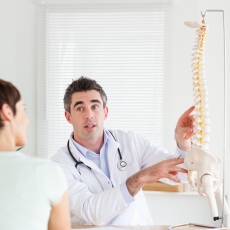

National Institutes of Health
Other Languages
New on the MedlinePlus Spinal Cord Diseases page:
05/01/2018 03:50 PM EDT
Source: National Library of Medicine - 

Your spinal cord is a bundle of nerves that runs down the middle of your back. It carries signals back and forth between your body and your brain. It is protected by your vertebrae, which are the bone disks that make up your spine. If you have an accident that damages the vertebrae or other parts of the spine, this can also injure the spinal cord. Other spinal cord problems include
- Tumors
- Infections such as meningitis and polio
- Inflammatory diseases
- Autoimmune diseases
- Degenerative diseases such as amyotrophic lateral sclerosis and spinal muscular atrophy
Symptoms vary but might include pain, numbness, loss of sensation and muscle weakness. These symptoms can occur around the spinal cord, and also in other areas such as your arms and legs. Treatments often include medicines and surgery.
- Cerebrospinal Fluid (CSF) Analysis
 (National Library of Medicine)Also in Spanish
(National Library of Medicine)Also in Spanish - Discography (North American Spine Society)
- Magnetic Resonance Imaging (MRI) - Spine(American College of Radiology, Radiological Society of North America)Also in Spanish
- Specialized Nerve Tests: EMG, NCV and SSEP (North American Spine Society)
- Childhood Brain and Spinal Cord Tumors Treatment Overview
 (National Cancer Institute)Also in Spanish
(National Cancer Institute)Also in Spanish - Childhood Central Nervous System Germ Cell Tumors Treatment
 (National Cancer Institute)Also in Spanish
(National Cancer Institute)Also in Spanish - Evaluating and Treating Transverse Myelitis (American Academy of Neurology) - PDF
- Dressing with Ease, Style and Comfort (ALS Association) - PDF
- Brain and Spinal Cord Tumors in Adults (American Cancer Society)
- Brown-Sequard Syndrome
 (National Institute of Neurological Disorders and Stroke)
(National Institute of Neurological Disorders and Stroke) - Central Pain Syndrome
 (National Institute of Neurological Disorders and Stroke)
(National Institute of Neurological Disorders and Stroke) - Hydromyelia
 (National Institute of Neurological Disorders and Stroke)
(National Institute of Neurological Disorders and Stroke) - Spinal Cord Tumor (Mayo Foundation for Medical Education and Research)
- Spinal Infections (North American Spine Society)
- Stiff-Person Syndrome
 (National Institute of Neurological Disorders and Stroke)
(National Institute of Neurological Disorders and Stroke) - Tabes Dorsalis
 (National Institute of Neurological Disorders and Stroke)
(National Institute of Neurological Disorders and Stroke) - Tarlov Cysts
 (National Institute of Neurological Disorders and Stroke)
(National Institute of Neurological Disorders and Stroke) - Tethered Spinal Cord Syndrome
 (National Institute of Neurological Disorders and Stroke)
(National Institute of Neurological Disorders and Stroke) - Transverse Myelitis
 (National Institute of Neurological Disorders and Stroke) - Short Summary
(National Institute of Neurological Disorders and Stroke) - Short Summary - Transverse Myelitis
 (National Institute of Neurological Disorders and Stroke)Also in Spanish
(National Institute of Neurological Disorders and Stroke)Also in Spanish
- Genetics Home Reference: caudal regression syndrome
 (National Library of Medicine)
(National Library of Medicine)
- What Are the Key Statistics about Brain and Spinal Cord Cancers? (American Cancer Society)Also in Spanish
- ClinicalTrials.gov: Spinal Cord Diseases
 (National Institutes of Health)
(National Institutes of Health)
- Anatomy of the Spine (North American Spine Society)
- Definitions A-Z (North American Spine Society)
- Find a Neurologist (American Academy of Neurology)
- National Institute of Neurological Disorders and Stroke
 Also in Spanish
Also in Spanish
- What Are the Risk Factors for Brain and Spinal Cord Tumors in Children? (American Cancer Society)Also in Spanish
- Epidural abscess (Medical Encyclopedia)Also in Spanish
- Spinal cord abscess (Medical Encyclopedia)Also in Spanish
- Spinal tumor (Medical Encyclopedia)Also in Spanish
- Subacute combined degeneration (Medical Encyclopedia)Also in Spanish
- Syphilitic myelopathy (Medical Encyclopedia)Also in Spanish






















.png)











No hay comentarios:
Publicar un comentario